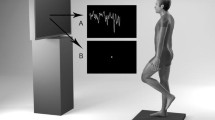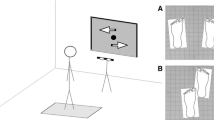Abstract
Two experiments investigated the role of optic flow in controlling posture. Both experiments measured postural sway in two virtual environments with different 3-D structure but the same optic flow. Observers attempted to maintain balance on one foot while viewing an object that appeared either rigid with respect to the environment or that appeared to move concomitantly with head movements. The apparent object motion concomitant with head motion was achieved by changing the perceived, but not physical, depth of the object. For both objects, the optic flow information was the same and only depth information was varied. Observers showed a decrease in stability (as measured by head sway) when viewing the object that appeared to move, suggesting that perceived relative motion, not optic flow, signals self-motion to the postural control system.







Similar content being viewed by others
Notes
The system latency consists of 33.3 ms due to double-buffering of the graphics card (running at 60 Hz), plus an average of 8.3 ms (range of 0–16.6 ms) asynchrony between the position tracker frame rate (60 Hz) and graphics frame rate (60 Hz).
References
Begbie GH (1967) Some problems of postural sway. In: de Reuck AVS, Knight J (eds) Myotatic, kinesthetic, and vestibular mechanisms. J & A Churchill, London, pp 80–92
Beusmans JMH (1998) Perceived object shape affects the perceived direction of self-movement. Perception 27:1079–1085
Brunswik E (1941) Perceptual size-constancy in life situations. Psychol Bull 38:611–612
Brunswik E (2001) Distal focusing of perception: Size constancy in a representative sample of situations. In: Hammond KR, Stewart RT (eds) The essential Brunswik: Beginnings, explications, applications. Oxford University Press, New York, pp 67–105
Diener HC, Dichgans J, Bacher M, Gompf B (1984) Quantification of postural sway in normals and patients with cerebellar diseases. Electroen Clin Neuro 57:134–142
Dijkstra TMH, Gielen CCAM, Melis BJM (1992) Postural responses to stationary and moving scenes as a function of distance to the scene. Human Movement Sci 11:195–203
Dijkstra TMH, Schöner G, Gielen CCAM (1994) Temporal stability of the action-perception cycle for postural control in a moving visual environment. Exp Brain Res 97:477–486
Edwards AS (1946) Body sway and vision. J Exp Psychol 36:526–535
Foley JM (1980) Binocular distance perception. Psychol Rev 87:411–434
Gilinsky AS (1951) Perceived size and distance in visual space. Psychol Rev 58:460–482
Gogel WC (1980) The sensing of retinal motion. Percept Psychophys 28(2):155–163
Gogel WC (1990) A theory of phenomenal geometry and its applications. Percept Psychophys 48(2):105–123
Lasley DJ, Hamer RD, Dister R, Cohn TE (1991) Postural stability and stereo-ambiguity in man-designed visual environments. IEEE T Biomed Eng 38(8):808–813
Lee DN, Lishman JR (1975) Visual proprioceptive control of stance. J Hum Movement Stud 1:87–95
McCready D (1985) On size, distance, and visual angle perception. Percept Psychophys 37(4):323–334
Okuzumi H, Tanaka A, Nakamura T (1996) Age-related changes in the magnitude of postural sway in healthy women. J Hum Movement Stud 31:249–261
Paulus WM, Straube A, Brandt T (1984) Visual stabilization of posture: Physiological stimulus characteristics and clinical aspects. Brain 107:1143–1163
Papathomas TV (2002) Experiments on the role of painted cues in Hughes’s reverspectives. Perception 31:521–530
Riley MA, Mitra S, Stoffregen TA, Turvey MT (1997) Influences of lean and vision on unperturbed postural sway. Motor Control 1:229–246
Schöner G (1991) Dynamic theory of perception-action patterns: the “moving room” paradigm. Biol Cybern 64:455–462
Stoffregen TA, Smart LJ, Bardy BG, Pagulayan RJ (1999) Postural stabilization of looking. J Exp Psychol Human 25(6):1641–1658
Thouless RH (1931) Phenomenal regression to the real object, I. Brit J Psychol 21:339–359
Van Asten WNJC, Gielen CCAM, van der Gon JJD (1988) Postural adjustments induced by simulated motion of differently structured environments. Exp Brain Res 73:371–383
Wade NJ, Hughes P (1999) Fooling the eyes: trompe l’oeil and reverse perspective. Perception 28:1115–1119
Warren WH (1998) Visually controlled locomotion: 40 years later. Ecol Psychol 10(3–4):177–219
Warren WH, Kay BA, Yilmaz EH (1996) Visual control of posture during walking: functional specificity. J Exp Psychol Human 22(4):818–838
Witkin HA, Wapner S (1950) Visual factors in the maintenance of upright posture. Am J Psychol 63:31–50
Acknowledgements
Experiment 1 was presented at the Vision Sciences Society meeting, May 2003. The authors thank three anonymous reviewers for constructive comments on the manuscript, and Kristen Macuga for helpful comments at all stages of this research. Supported by AFOSR grant F49620–02–1-0145.
Author information
Authors and Affiliations
Corresponding author
Rights and permissions
About this article
Cite this article
Kelly, J.W., Loomis, J.M. & Beall, A.C. The importance of perceived relative motion in the control of posture. Exp Brain Res 161, 285–292 (2005). https://doi.org/10.1007/s00221-004-2069-9
Received:
Accepted:
Published:
Issue Date:
DOI: https://doi.org/10.1007/s00221-004-2069-9




